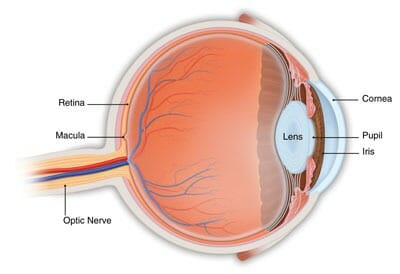Information on the Common Eye Condition: Age-Related Macular Degeneration

AMD or Age-Related Macular Degeneration
Age-related Macular Degeneration (AMD), a medical condition typically affecting adults in their later years, results in vision loss, predominantly in the very center of the macula (or visual field). When macular degeneration occurs, it tends to be due to retinal damage.
AMD occurs in two distinct forms: wet, and dry. Often, blindness and visual impairment later in life are due to Age-related Macular Degeneration. At its worst, AMD can drastically reduce an individual’s ability to read things, up to and including total prevention. Similarly, recognizing faces may be rendered impossible due to the condition.
Strangely enough, even with AMD, people tend to be able to see well enough using their peripheral vision so as not to be prevented from enjoying other activities in daily life.
More Information to Consider With AMD: Signs and Symptoms
Some of the following signs and symptoms tend to signal the onset of Age-related Macular Degeneration:
- hemorrhages in the area of the eye, subretinal/intraretinal fluid
- drastic decrease in visual acuity of 2 or more levels
- blurred vision, or gradual loss of central vision
- missing areas of vision, or the appearance of “shadows”
- some difficulty making out colors, especially with regard to light/dark differences (contrast)
- eye function recovers very slowly after the field of vision has been exposed to bright light
Causes of and Treatment for Age-related Macular Degeneration
Typically occurring in adults above the age of 50, with increased risk developing as a person gets older. Some risk factors associated with AMD include:
- Family History: if you have a history of AMD in your family, you are in a higher risk group for getting AMD yourself
- Smoking: thought it was just bad for your lungs? Researchers have proven that smoking doubles your risk of developing AMD
- Race: when compared to people of African descent, Caucasians are far more likely to develop AMD
Of the two varieties of AMD, the dry version tends to exhibit very few symptoms during the early stages of development. With regular eye examinations from a trained optometrist, symptoms are much more likely to be properly diagnosed early on. Once AMD has been diagnosed, regular eye examinations are highly recommended, in order to manage the progress of the disease.
As AMD progresses into more developed stages, blurred vision tends to accompany the dry version. A dimming of objects in the field of vision may also persist as AMD develops. If you are having trouble recognizing people’s faces, especially those close to you (whom you once were easily able to identify, in other words), it is important to consult an optometrist.
There are a number of treatment options for dealing with wet AMD, all of which will be explained during a routine eye examination by your optometrist.
[Diagram Via: Geteyesmart]

